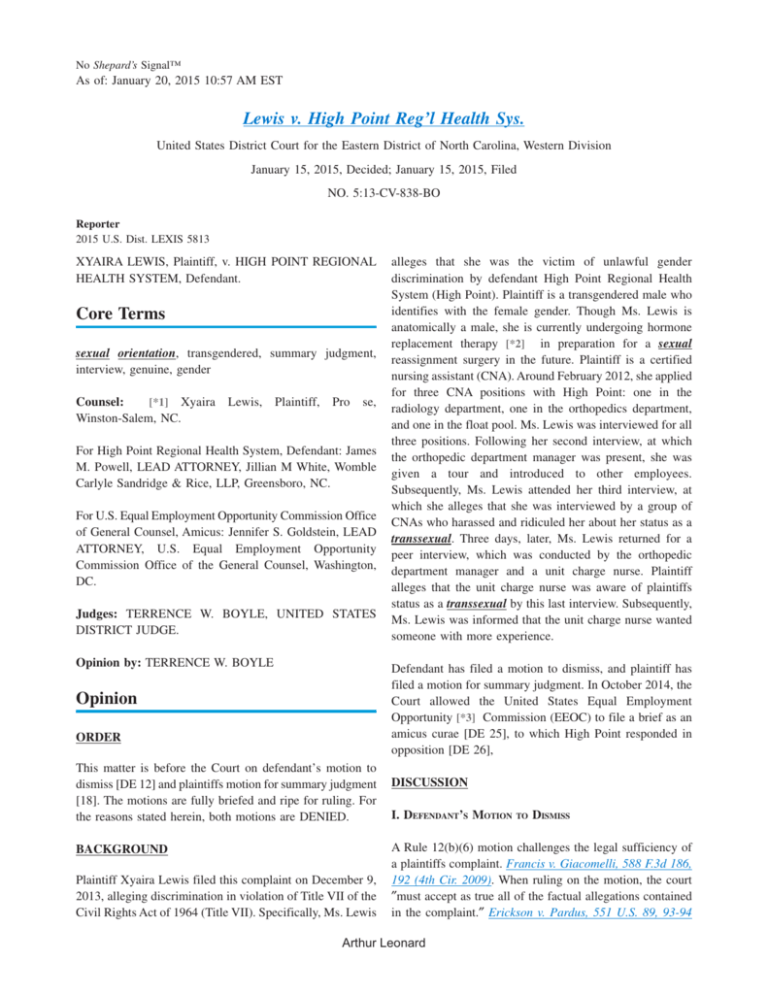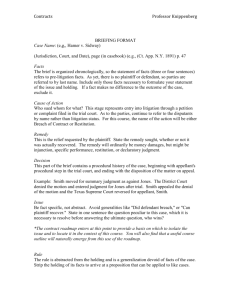Lewis v. High Point Regional Health System
advertisement

No Shepard’s Signal™ As of: January 20, 2015 10:57 AM EST Lewis v. High Point Reg’l Health Sys. United States District Court for the Eastern District of North Carolina, Western Division January 15, 2015, Decided; January 15, 2015, Filed NO. 5:13-CV-838-BO Reporter 2015 U.S. Dist. LEXIS 5813 XYAIRA LEWIS, Plaintiff, v. HIGH POINT REGIONAL HEALTH SYSTEM, Defendant. Core Terms sexual orientation, transgendered, summary judgment, interview, genuine, gender [*1] Xyaira Counsel: Winston-Salem, NC. Lewis, Plaintiff, Pro se, For High Point Regional Health System, Defendant: James M. Powell, LEAD ATTORNEY, Jillian M White, Womble Carlyle Sandridge & Rice, LLP, Greensboro, NC. For U.S. Equal Employment Opportunity Commission Office of General Counsel, Amicus: Jennifer S. Goldstein, LEAD ATTORNEY, U.S. Equal Employment Opportunity Commission Office of the General Counsel, Washington, DC. Judges: TERRENCE W. BOYLE, UNITED STATES DISTRICT JUDGE. Opinion by: TERRENCE W. BOYLE alleges that she was the victim of unlawful gender discrimination by defendant High Point Regional Health System (High Point). Plaintiff is a transgendered male who identifies with the female gender. Though Ms. Lewis is anatomically a male, she is currently undergoing hormone replacement therapy [*2] in preparation for a sexual reassignment surgery in the future. Plaintiff is a certified nursing assistant (CNA). Around February 2012, she applied for three CNA positions with High Point: one in the radiology department, one in the orthopedics department, and one in the float pool. Ms. Lewis was interviewed for all three positions. Following her second interview, at which the orthopedic department manager was present, she was given a tour and introduced to other employees. Subsequently, Ms. Lewis attended her third interview, at which she alleges that she was interviewed by a group of CNAs who harassed and ridiculed her about her status as a transsexual. Three days, later, Ms. Lewis returned for a peer interview, which was conducted by the orthopedic department manager and a unit charge nurse. Plaintiff alleges that the unit charge nurse was aware of plaintiffs status as a transsexual by this last interview. Subsequently, Ms. Lewis was informed that the unit charge nurse wanted someone with more experience. Defendant has filed a motion to dismiss, and plaintiff has filed a motion for summary judgment. In October 2014, the Court allowed the United States Equal Employment Opportunity [*3] Commission (EEOC) to file a brief as an amicus curae [DE 25], to which High Point responded in opposition [DE 26], Opinion ORDER This matter is before the Court on defendant’s motion to dismiss [DE 12] and plaintiffs motion for summary judgment [18]. The motions are fully briefed and ripe for ruling. For the reasons stated herein, both motions are DENIED. BACKGROUND Plaintiff Xyaira Lewis filed this complaint on December 9, 2013, alleging discrimination in violation of Title VII of the Civil Rights Act of 1964 (Title VII). Specifically, Ms. Lewis DISCUSSION I. DEFENDANT’S MOTION TO DISMISS A Rule 12(b)(6) motion challenges the legal sufficiency of a plaintiffs complaint. Francis v. Giacomelli, 588 F.3d 186, 192 (4th Cir. 2009). When ruling on the motion, the court ″must accept as true all of the factual allegations contained in the complaint.″ Erickson v. Pardus, 551 U.S. 89, 93-94 Arthur Leonard Page 2 of 3 2015 U.S. Dist. LEXIS 5813, *4 (2007) (citing Bell Atl. Corp. v. Twombly, 550 U.S. 544, 555-56 (2007). Specificity is not required; the complaint need only ″give the defendant fair notice of what the . . . claim is and the grounds upon which it rests.″ Twombly, 550 U.S at 555 (quotation omitted). To survive a Rule 12(b)(6) motion, a complain must contain facts sufficient ″to raise a right to relief above the speculative level″ and to satisfy the court that the claim is ″plausible on its face.″ Id. at 555, 570; see also Ashcroft v. Iqbal, 556 U.S. 662, 678 (2009). Defendant High Point’s motion to dismiss relies on, inter alia, Wrightson v. Pizza Hut of America, Inc., 99 F.3d 138, 143 (4th Cir. 1996), and argues that Title VII does not provide a cause of action for discrimination based on sexual orientation. High Point is correct in that neither the United States Supreme Court nor that Fourth Circuit Court of Appeals has recognized Title VII as protecting individuals because of their sexual orientation. See, e.g., Oncale v. Sundowner Offshore Services, Inc., 523 U.S. 75, 78-80 (1998); Wrightson v. Pizza Hut of America, Inc., 99 F,3d 138, 143 (4th Cir. 1996). However, neither the Supreme Court nor the Fourth Circuit’s [*4] Title VII jurisprudence has addressed transgendered status, which, as amicus EEOC points out, is different than sexual orientation. on the basis [*5] of her sexual orientation. Accordingly, defendant’s motion to dismiss is DENIED.2 II. PLAINTIFF’S MOTION FOR SUMMARY JUDGMENT Summary judgment is proper only when, viewing the facts in the light most favorable to the non-moving party, there is no genuine issue of material fact, and the movant is entitled to judgment as a matter of law. Fed. R. Civ. P. 56; Celotex Corp. v. Catrett, 477 U.S. 317, 322-23 (1986); Cox v. Cnty. of Prince William, 249 F,3d 295,299 (4th Cir. 2001). An issue is genuine if a reasonable jury, based on the evidence, could find in favor of the non-moving party. Anderson v. LibertyLobby, Inc., A l l U.S. 242, 248 (1986); Cox, 249 F.3d at 299. In determining whether a genuine issue of material fact exists for trial, a trial court views the evidence and the inferences in the light most favorable to the nonmoving [*6] party. Scott v. Harris, 550 U.S. 372, 378 (2007). As the moving party, plaintiff has the burden of demonstrating that a fact is not genuinely disputed by citing to ″particular parts of materials in the record″ that are admissible in evidence. Fed. R. Civ. P. 56(c). ″The ultimate question in every employment discrimination case involving a claim of disparate treatment is whether the plaintiff was A transgendered person is defined as an individual ″who the victim of intentional discrimination.″ Reeves v. Sanderson identifies with or expresses a gender identity that differs Plumbing Prods., Inc., 530 IU.S. 133, 153 (2000). Therefore, in order to prevail on her summary judgment claim, plaintiff from the one which corresponds to the person’s sex at must be able to demonstrate through admissible evidence birth.″ Merriam Webster Online Dictionary, Transgender that High Point intentionally discriminated against her (January 14, 2015), http://www.merriam-webster. com/ because of her transgendered status. At this stage, plaintiff dictionary/transgender. Sexual orientation is defined as cannot meet her burden. Plaintiff has provided no evidence ″the inclination of an individual with respect to heterosexual, establishing that the Hospital’s reason for not hiring her was homosexual, and bisexual behavior.″ Id., Sexual Orientation because she is transgendered. The parties have not yet (January 14, 2015) engaged in discovery and plaintiff has submitted no affidavits http://www.merriam-webster.com/medical/sexual%20orientation.in support of her motion, instead relying on the EEOC’s The difference between the two is further underscored by reasonable cause determination letter, the EEOC the language used in the pending legislation cited by High investigator’s typed notes of witness interviews, and internet Point in its motion to dismiss. In 2013, the Senate passed sources discussing transgender rights. Bill 815, titled the ″Employment Non-Discrimination Act,″ which makes it illegal for private employers to discriminate Plaintiff may not use the EEOC’s determination letter as against individuals in the workplace on account of their undisputed [*7] evidence of intentional discrimination by sexual orientation or gender identity. Senate Bill 815, 113th the Hospital. Laber v. Harvey, 438 F.3d 404,420-21 (4th Cir. Cong. §§ 4, 6, 7, (2013). The distinct nomenclature 2006); see also Georator Corp. v. E.E.O.C., 592 F.2d underscores the fact that the two are different concepts.1 765,768 (4th Cir. 1979). The Supreme Court has held ″that Nowhere in her complaint does plaintiff allege discrimination a private-sector employee was required to introduce a 1 Congress has not passed the Employment Non-Discrimination Act. The Court does not rely on it for any substantive purpose, but merely cites it to as support for the proposition that sexual orientation and gender identity are separate issues. 2 The Court recognizes that the EEOC’s amicus brief raises a question of whether plaintiff’s complaint fits within a gender-stereotyping framework. Because this issue was not raised in defendant’s motion to dismiss, the Court declines to address it at this time. Arthur Leonard Page 3 of 3 2015 U.S. Dist. LEXIS 5813, *7 genuine issue of material fact on his Title VII claim despite the fact the EEOC had made a finding of reasonable cause on that claim.″ Laber, 438 F,3d at 420 (quoting McDonnell Douglas Corp. v. Green, 411 U.S. 792 (1973). Moreover, the EEOC investigator’s notes are nothing more than inadmissible hearsay. Fed R. Evid. 801. Even if they were admissible, they demonstrate that legitimate non-discriminatory reasons exist for plaintiff not being hired. Accordingly, plaintiff cannot meet her burden to demonstrate that there is no genuine issue of material fact as to whether High Point intentionally discriminated against her and summary judgment in her favor is inappropriate. Plaintiffs motion is DENIED. CONCLUSION For the foregoing reasons, defendants’ motion to dismiss [DE 12] and plaintiffs motion for summary judgment [DE 18] are DENIED. SO ORDERED, this 15 day of January, 2015. /s/ Terrence W. Boyle TERRENCE W. BOYLE UNITED STATES DISTRICT JUDGE Arthur Leonard




![[2012] NZEmpC 75 Fuqiang Yu v Xin Li and Symbol Spreading Ltd](http://s3.studylib.net/store/data/008200032_1-14a831fd0b1654b1f76517c466dafbe5-300x300.png)

